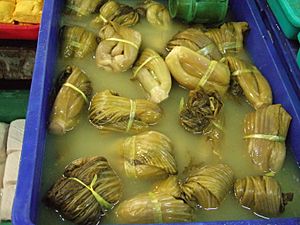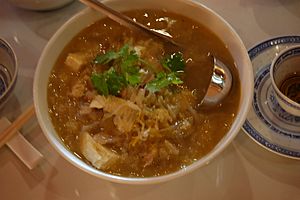Suan cai facts for kids
Quick facts for kids Suan cai |
|||||||||||||||||||||
|---|---|---|---|---|---|---|---|---|---|---|---|---|---|---|---|---|---|---|---|---|---|

A tub of suancai made from Chinese mustard.
|
|||||||||||||||||||||
| Chinese | 酸菜 | ||||||||||||||||||||
| Hanyu Pinyin | suān cài ΩΩ | ||||||||||||||||||||
| Literal meaning | Sour vegetable | ||||||||||||||||||||
|
|||||||||||||||||||||
| Alternative Chinese name | |||||||||||||||||||||
| Chinese | 鹹菜 | ||||||||||||||||||||
| Hanyu Pinyin | xián cài | ||||||||||||||||||||
| Literal meaning | Salty vegetable | ||||||||||||||||||||
|
|||||||||||||||||||||
Suancai (pronounced "swahn-tsai") is a traditional Chinese dish. It is made from Chinese cabbage (like napa cabbage) or Chinese mustard. These vegetables are pickled, which means they are preserved in a special way. Suancai is sometimes called "Chinese sauerkraut" because it is similar to the German dish. It is a special type of paocai, which is a general term for pickled vegetables in China.
Contents
The History of Suancai
The first records of Suancai in China are very old. They come from a book called The Book of Odes. This book was written between the 11th and 7th centuries BC. Back then, fermented vegetables were used in special ceremonies. People offered them to their ancestors.
One old poem describes how people made suancai. They pickled gourds to offer them. This shows that people have been pickling vegetables for a very long time.
Around the 7th century BC, workers building the Great Wall of China ate mostly cabbages and rice. To keep their vegetables fresh in winter, they added rice wine to the cabbages. This made the cabbages ferment and turn sour. This was an early way to make suancai.
Later, a book from the Northern Wei Dynasty (386-534 AD) shared many recipes. This book, called Ch’i Min Yao Shu, explained how to make 18 different kinds of suancai. Some recipes used plain vegetables, while others added salt. This shows that suancai was a very popular food across China.
How Suancai Is Made
There are two main types of suancai in China. The type depends on the vegetable used.
- In Northern China, people traditionally use Napa cabbage (called dàbáicài).
- In Southern and Western China, they use thick-stalked Chinese mustard (called jìecai).
Making suancai is different from making other pickled vegetables. The vegetables are pressed down. This is done by putting a heavy object, like a large rock, on top of the container. This slowly presses the cabbage as it ferments. This pressing helps create the special taste of suancai.
The process of making suancai takes about one month. It happens at room temperature. Salt is very important in this process. It helps good microbes grow and gives suancai its great flavor. More salt can lead to better quality and taste.
Adding certain nutrients can make suancai ferment faster. It can also lower the amount of a substance called nitrite. For example, adding things like Asp, Thr, Glu, Cys, Tyr, Mg2+, Mn2+, and inosine helps. If these are added, suancai can be ready 5 days faster. The nitrite content also becomes much lower.
Suancai Around the World
Suancai is enjoyed in many different places and in many ways.
Muslim Regions in China and Taiwan
In Chinese Islamic cuisine, suancai is often put on top of noodle soups. It is especially popular with beef noodle soup.
Hakka Cuisine
For the Hakka people, suancai (called soen choi) is a common ingredient. They use it in many dishes, including stir-fries.
Hunan Cuisine
In Hunan, suancai is often made with ginger and chilies. This gives it a spicy kick, which is common in Hunan cuisine.
Guangdong and Hong Kong
In Cantonese cuisine, suancai is often served as a small appetizer. Sometimes, you can find small containers of it right on the dining table. There are also Cantonese versions, like salted suancai (鹹酸菜).
Northeast China
In Northeastern Chinese cuisine, suancai is made from napa cabbage or regular cabbage. It tastes a lot like sauerkraut. People in Manchuria use it in dumplings. They also boil it or stir-fry it. A very popular dish is suancai and pork stew.
Hot Pot
Suancai is often one of the ingredients in hot pot meals.
Sichuan Cuisine
In Sichuan cuisine, there is a dish called suancai yu (simplified Chinese: 酸菜鱼; traditional Chinese: 酸菜魚; pinyin: Suāncài yú). This dish features suancai served in a tasty broth with fish.
In Thailand
Suancai is also used in Thai cuisine. It is known as phak kat dong. It is often used in Thai-Chinese dishes. You can also find it in Thai salads or as a side dish. For example, it is used with khao soi, a northern Thai curry-noodle soup.
In Vietnam
Pickled cabbage, called dưa cải chua, is a traditional food in northern Vietnamese cuisine. It is used in dishes like canh cải chua (sour cabbage soup). It is also found in cơm rang dưa bò (fried rice with beef and pickles).
Suancai and Sauerkraut
Suancai is very similar to sauerkraut. Sauerkraut is another dish made from fermented cabbage. It is popular in countries in Central and Eastern Europe. Both dishes show how different cultures have found ways to preserve vegetables.
Suancai in Pop Culture
A popular TV show and song from Northeast China is called Cui Hua Shang Suancai. It means "Cui Hua, serve the suancai." This show became very famous in 2001. The phrase "Cui Hua Shang Suancai" became a popular saying. "Cui Hua" even became a nickname for people from Northeast China. A company in China now sells packaged suancai under the "Cui Hua" brand. In Vietnam, this traditional dish is called "dưa cải muối." People often eat it directly or stir-fry it with meat or cook it in soup.
See also
 In Spanish: Suan cai para niños
In Spanish: Suan cai para niños




